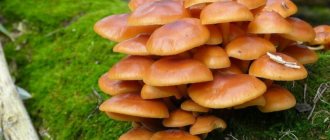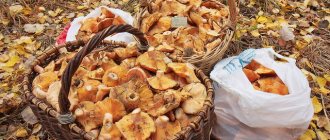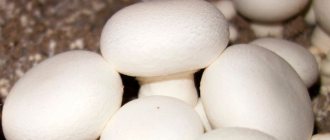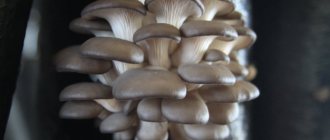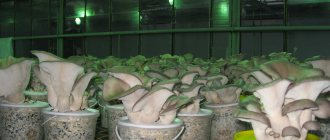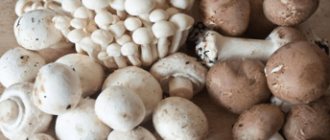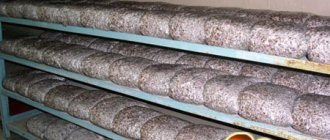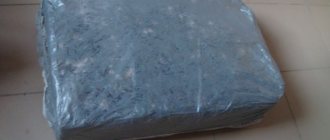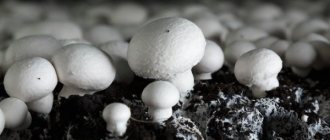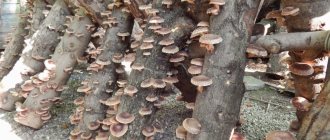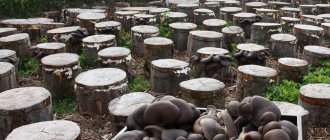Agree, most citizens of our country like to eat mushrooms in various forms. They have a large number of useful properties and there are no contraindications. And how many recipes are there: pickled, fried, canned, as an addition to soup or sauce. But only a few can afford to eat them every day.
So why not try growing mushrooms at home for beginners in your basement? Mushroom farming is a profitable business, which, moreover, does not require special material costs or physical effort. But in order to regularly harvest a good harvest, which would be enough not only for your own family, but also for sale, you need to know several features of the business. It is them that we will analyze in the article.
Features and technology of growing champignons in the basement
Growing mushrooms at home and selling them is a very profitable business that can bring profit. But in order to grow champignons at home in the basement, you need to know all the intricacies of the matter. Otherwise, instead of additional income, you will incur losses.
Growing different varieties of champignons in the basement is only possible if special conditions are created for the mushrooms in which they will be comfortable growing. The growing process itself is not complicated and does not require your intervention. But the preparatory stage is very serious.
You need to start with the fact that mushrooms will not grow in ordinary soil. For this purpose, only special compost for growing champignons is suitable, which is made specifically for growing this variety of mushrooms. It is impossible to make it yourself, so just contact your nearest specialized store.
Many manufacturers offer compost, which is already seeded with mycelium, in the form of compressed briquettes or bags, at an affordable price. They are small in size and easy to transport even on the trunk of a bicycle.
Space zoning
If your cellar is large enough, it makes sense to divide it into two zones. You will use one room for incubation (spread of mycelium over the substrate), and the second for direct forcing of mushrooms (fruiting bodies). The temperature required for the successful completion of these processes is different. The mycelium grows at approximately 23 degrees, and fruiting occurs at 16–17 degrees.
By maintaining stable temperature conditions in each room, you can simply move the boxes with the substrate. In this way, you can grow champignons continuously - while half of the boxes bear fruit, mycelium grows in the other, and so on. If necessary, you can add a third zone for composting.
To save space in the basement, racks with mushrooms can be arranged in several floors (tiers).
Preparing the premises and creating conditions for growing champignons
To grow champignons in the basement, you need to prepare it in a special way and provide ideal conditions for the plants. It doesn’t matter what material the walls are made of, the main thing is to pre-concrete the floor, if this has not been done before. This way, you can avoid the penetration of rodents and insects, fungi and excessive amounts of moisture from groundwater. In addition, it is in the basement that it is easiest to create the desired level of humidity and air temperature.
Next, it is important that all points are met:
- All foreign things and objects must be removed from the cellar. It is advisable that the room be empty.
- Disinfect the basement thoroughly. It is best to use a sulfur bomb for this and whitewash the walls with lime with the addition of a small amount of copper sulfate. This will kill all infections and microorganisms that can harm the champignons. If there are insects that crawl or fly, additionally treat with dichlorvos.
- Additionally insulate the walls. This will create a thermos effect and will not allow the temperature to quickly drop or rise. The best option is to use foam boards. Despite their low cost, they are very effective.
- As for lighting, just one light bulb will be enough, which is needed for your work. A distinctive feature of champignons is that they do not require sunlight to grow.
- Particular attention should be paid to room ventilation. It should be divided into two types: exhaust and supply. It is logical that carbon dioxide will be removed from the basement through the exhaust pipe, which will appear in large quantities during the decomposition of the substrate. But fresh air will flow through the supply pipe. It is important to equip both pipes with a very fine mesh inside. This will prevent insects and rodents from entering the cellar.
- Monitor the level of air humidity all the time; the indicator should not fall below 60-70%. A special device, a hygrometer, which you must buy and install, will help you find out how humid the air is.
- Also hang a thermometer. The thing is that at different stages of mushroom development they need different temperatures.
Only after such careful preparation can you proceed directly to the process of growing champignons in your own basement.
Substrate preparation
The substrate for growing champignons should be loose and nutritious, slightly springy and soft, with an acidity level of 7.3-7.5 pH. To get a good harvest of mushrooms, you should prepare it according to the instructions.
Depending on the type of champignon, the preparation methods and compositions of compost may be different. But there are basic principles for its preparation as a universal one. The best option is compost made from horse manure. It is recommended that animals eat hay rather than green food.
1 composition:
horse manure (with a high straw content and a moisture content of 40-45%) - 850 kg;
- gypsum – 18 kg;
- urea – 3 kg;
- ammonium nitrate – 8 kg;
- superphosphate – 13 kg
2 composition:
- horse manure – 2 thousand kg;
- chalk – 7.5 kg;
- straw – 50 kg;
- urea – 5 kg;
- ammonium sulfate – 8 kg;
- superphosphate – 5 kg.
Horse manure can be replaced with cow or poultry manure, but in this case the harvest will be worse. After preparing all the necessary ingredients, you need to soak the straw in warm water for 2 days. Then it is placed in a pile mixed with layers of manure. In total you should get 6-8 layers, each of which needs to be moistened with warm water.
After a few days, the compost should be thoroughly mixed, and then urea and superphosphate should be added. After another 3-4 days, the compost is mixed again and the remaining ingredients are added. Finally, during the last mixing, gypsum and chalk are added.
It is best to prepare the substrate in a special utility room with good ventilation, or outdoors under a canopy that will protect it from sunlight and precipitation.
On average, compost preparation takes 24-28 days. Ready humus is characterized by the absence of ammonia odor and light brown color. To grow mushrooms, the compost temperature should be no more than 25 degrees.
The finished substrate must be moved to the basement and placed in boxes or containers in which it is planned to grow champignons.
If you find it too difficult to make your own compost, you can always buy it at the store, but homemade compost is of better quality.
Planting champignon mycelium
As mentioned above, you can grow mushrooms at home only if you have a special substrate or champignon compost. The finished substrate, which is sold in specialized stores, is already seeded with mycelium according to all the rules. Preparing compost will take a long time and is only worthwhile on large farms.
That is why, at this stage, to grow champignons you will no longer need to adhere to special requirements. The professionals did it for you.
When the packages with special soil are already placed in the cellar, leave them there for several days. This way they will reach the same temperature and will be able to gradually adapt to new conditions.
It is better to place them on racks, in the form of a kind of bed, 140 cm wide. Carefully cut the polyethylene, and gradually distribute the mixture so that its height does not exceed 20 cm. Cover the improvised beds with paper or newspapers on top.
As for moisturizing, at the initial stage you will have to spray the paper with water from a spray bottle at the rate of 200 grams per 1 square meter of soil. This incubation period will last from two to four weeks. As soon as the mycelium begins to emerge to the surface, it is time to apply casing soil, which is applied in a 4 cm layer. Water generously: 2 liters per 1 square meter of bed.
After 4 days, the mycelium begins to grow into the casing soil to a depth of about 5 mm. It is at this time that it is important to regularly moisten the soil. To do this, irrigate the soil in a proportion of 1 liter per 1 square meter, twice a day.
Only if everything is done correctly, after 12-14 days the mycelium will grow, pass through the entire volume of soil and reach the surface.
It is from this period that fruiting begins and watering stops.
Growing process
When all the conditions for growing champignons in the basement have been met, you can proceed directly to the process. The easiest way for beginners is to present it in the form of a step-by-step algorithm:
- We plant the mycelia in the substrate. As a rule, for growing at home, entrepreneurs purchase mycelium ready for planting. Most often, this is a base grown in special laboratories in which ideal sterility conditions are maintained. They buy mycelium for planting through intermediaries - on the Internet, “Everything for the Garden” stores, and also directly from suppliers.
- It is very simple to calculate the required amount of mycelium: 1 m2 - 500 grams of “living” medium. If you decide to grow mycelium from spores, you will need 400 grams.
- The planting process is not very different from the usual: you need to make holes about 5 cm deep. Properly prepared compost will feel a little springy. Keep a distance of at least 15-20 cm between the holes. Place a part of the mycelium in each hole.
- There is no need to make holes for planting spores. The seeds are simply sprinkled evenly onto the ground. The myceliums will pave their own “path.”
- During the incubation period, the entrepreneur’s task is to monitor the level of humidity and temperature conditions. How to do this is described in more detail below.
- To constantly moisten the soil, you can cover it with paper (cloth) and moisten it.
- 10-12 days after planting, cover the substrate with another layer of soil - literally 3-4 cm. The soil is prepared in a special way: peat + lime + soil in a ratio of 5: 1: 4.
- The incubation period will end in 4-5 days. All this time, regularly moisten the air and soil with a spray bottle.
- The next growing period is forcing. At this time, the temperature in the basement is lowered to 12-17 o C. Sometimes this is difficult to achieve; it is much easier to move the racks to another room. It is for this purpose that in the section above it was proposed to zone the basement.
- Soon the mushrooms will begin to grow. Follow the rules for collecting them and do not let the champignons overripe.
Fruiting and harvesting
During fruiting, the temperature in the cellar should be reduced to +14-+16, with a relative humidity of 85-95%. If you manage to create such conditions, then you will see the first fruits of your own labor in 15-20 days. As soon as you see white peas - mushroom caps - on the surface of the beds, watering should be resumed in the proportion of 1 liter per 1 square meter.
Mushroom picking is the final stage, but no less important. Each individual champignon, which has already reached the desired size, should be pulled out of the ground, carefully cut off the tip and root using a sharp knife and placed in a basket or box where they will be stored.
As you can see, growing champignons in a cellar is not at all difficult, and in order to organize mass cultivation, it is enough to do all the preparatory procedures once, and then enjoy the result.
Forcing fruiting bodies
After the incubation period, you should lower the temperature in the cellar to 12–17 degrees, or move the boxes with the substrate to the room for forcing (if, as mentioned at the beginning of the article, you divided the room into two compartments). The period of growth of the mushrooms themselves begins.
In one harvest, 5-8 waves of mushrooms can be removed from the mycelium, although the bulk will fall on the first three waves.
You can harvest the first wave of harvest in 3-4 months. Do not allow mushrooms to overripe. They should be picked when the lower part of the cap is still covered with a white film and the brown plates are not visible. Each mushroom must be carefully unscrewed from its place, and not cut off. Bacteria can enter the mycelium from the stem remaining after the cut.
After collecting the mushroom, the place where it grew should be lightly sprinkled with soil. The mushrooms will grow vigorously within 1-2 weeks. Under the right conditions and good compost, 5–8 mushroom harvests can be harvested during this time. The main volume falls on the first three waves. Then the yield of the mycelium will sharply decline.
Prevention of champignon diseases and pest control
Growing champignons in the basement also includes preventive measures and pest control if any appear in the cellar. Of course, diseases are much easier to prevent than to treat later. Therefore, it is very important to remove all cleaning, cuttings and other sources of biological contamination immediately.
As for diseases, brown spotting most often occurs in champignons, when dark spots appear on the caps and spread to the entire mushroom. The next stage is when the plant tissues die and the fungus dies completely. Mummification (when mushrooms stop growing) also often occurs.
In any case, the main reason is the substrate, which most likely was contaminated upon purchase, or bacteria began to develop due to improper storage or processing.
As soon as you notice the first signs of the disease, the container must be urgently removed from the room, otherwise it will infect other trays. For treatment, it is good to use bleach, which is used to water the beds.
Features and technology of growing oyster mushrooms in the basement
Oyster mushrooms rank second in popularity among the population in our country. And, of course, they can also be grown in a regular basement at home. But such a thing has its own characteristics, which differ from the rules for growing champignons. In nature, oyster mushrooms grow on stumps, but we will tell you how to grow them from a substrate in bags.
In fact, the main difference in growing mushrooms at home is that it can be done in two different ways - intensive and extensive. Extensive is considered much more profitable and beneficial, since growth conditions are as close as possible to natural ones and require virtually no human effort.
The advantage of intensive is that you get the harvest faster, and several times a year. But for this you need to create an optimal environment and constantly care for the plant.
In order to grow oyster mushrooms at home, you can use any of the methods, it all depends on your level of employment and interest in the quantity of the final product.
Pre-disinfection
To grow mushrooms in the basement (cellar), the room must be thoroughly disinfected and treated against parasites and mold. Champignons are very sensitive to diseases and pests, and it would be a shame to lose most of the harvest due to neglect of safety measures at the initial stage.
In particular, the following treatment can be carried out:
1.
Fumigate with a sulfur bomb.
2.
Whitewash the walls and ceiling with lime and copper sulfate.
3.
Spray with a 4 percent formaldehyde solution; if there were vegetables in the basement before and there are fruit flies or other pests, you need to treat the room with chlorophos.
4.
As an additional protective measure, you can place a box of sawdust soaked in a disinfectant solution at the entrance.
After disinfection, the basement should be thoroughly ventilated, otherwise it will be very difficult not only for the champignons, but also for you to stay inside.
Preparing the premises and creating the necessary microclimate
Growing oyster mushrooms in the basement involves creating a special microclimate. To do this, the following conditions must be met:
- The air temperature should be stable within 10-20 degrees. If the cellar is too cold, its walls can be insulated using polystyrene foam.
- Constantly high air humidity, at 85-90%. A hygrometer will help you check this parameter.
- A ventilation system that will remove carbon dioxide and deliver fresh air to the basement.
- Purity.
- Absence of mold, pests and other factors that can lead to fungal disease.
As you can see, the requirements are quite logical and differ little from the previous version.
Ventilation
The cellar must be equipped with a ventilation system, since the compost on which the champignons grow actively releases carbon dioxide during decomposition. But mushrooms cannot tolerate mustiness. Carbon dioxide must be removed and fresh air supplied in its place. However, drafts should not be allowed. The ventilation pipes are covered with fine mesh to prevent insects from getting inside.
If conventional supply and exhaust pipes are not enough for good ventilation of the cellar. You will have to take care of forced ventilation of the room. To organize air circulation above the boxes with champignons, you can use additional fans. If possible, it is worth installing additional air purification filters.
Preparation and sowing of mycelium
Before planting mycelium in the mycelium, you need to prepare a substrate in which oyster mushrooms will grow. It is very important to buy it in specialized stores or directly from farms where the mushroom is grown. The straw is soaked and then dried well to avoid rotting and the appearance of fungus.
Mycelium can also be purchased from the same store. Remember, it should not have an unpleasant odor or have dark spots that are visible through the transparent packaging.
Leave the bag in the basement for a day so that it gradually reaches the desired temperature. Next, carefully open the package on a sterile table, wearing gloves. Using smooth movements, scatter the mycelium over the substrate and mix it gently. The number of mushrooms should be about 3% of the soil mass.
Pour the resulting mixture into plastic bags, compact well and tie. This completes the planting of oyster mushrooms for growing in the basement.
